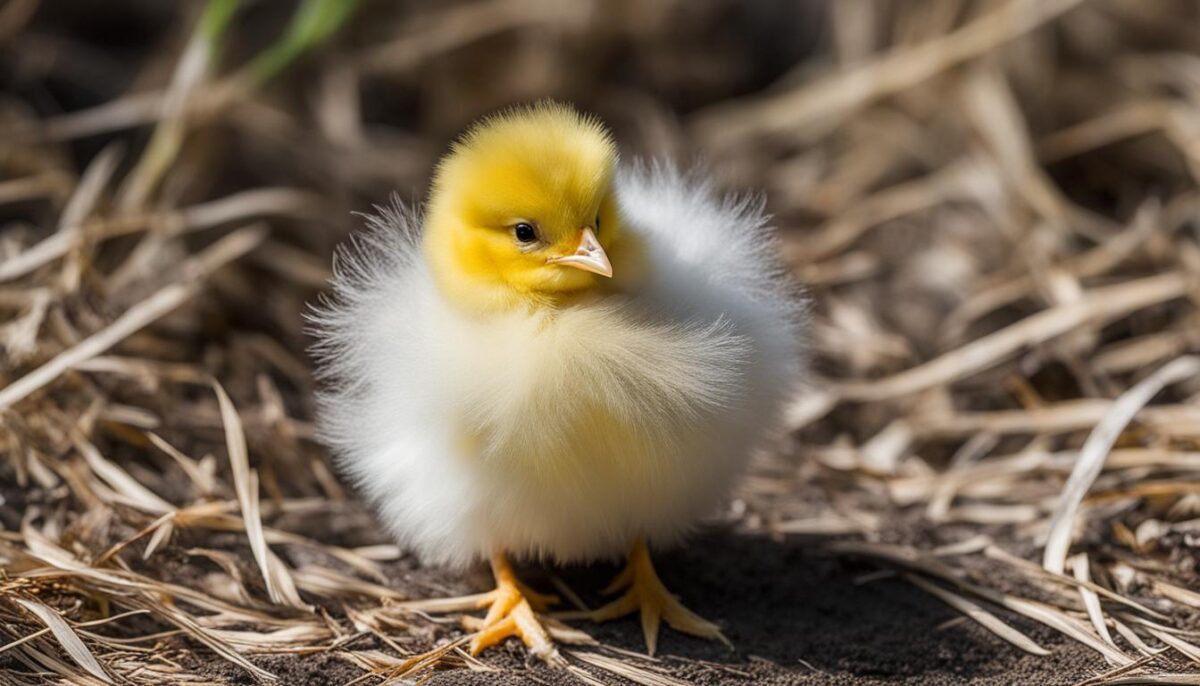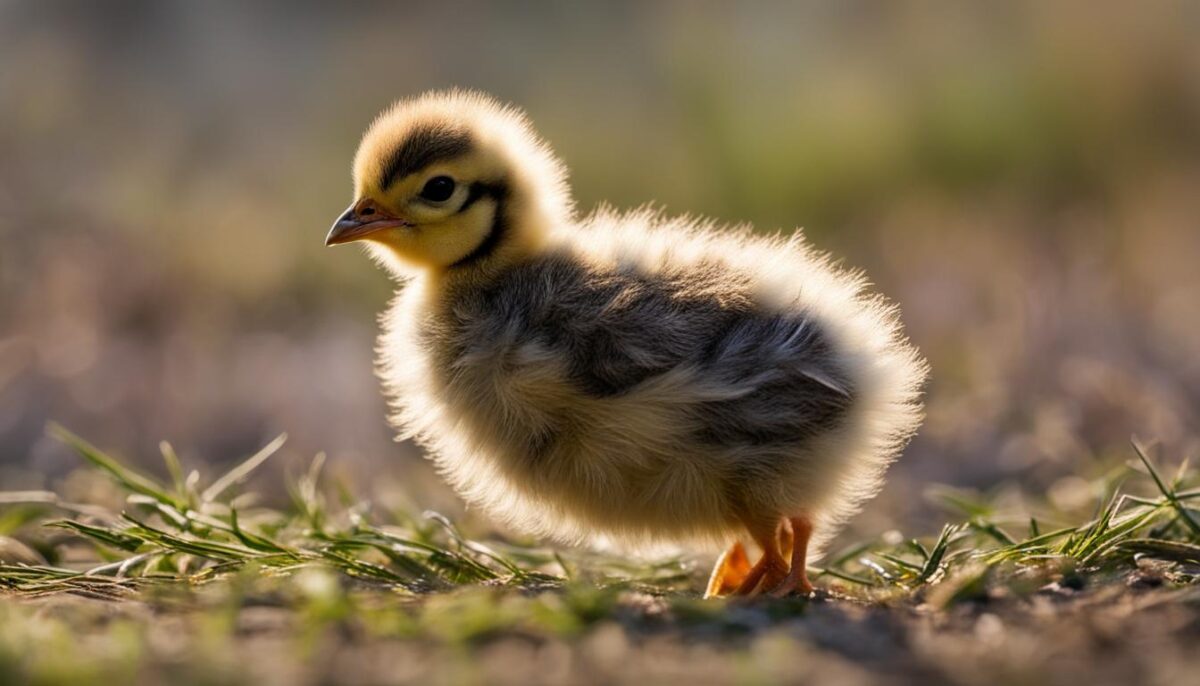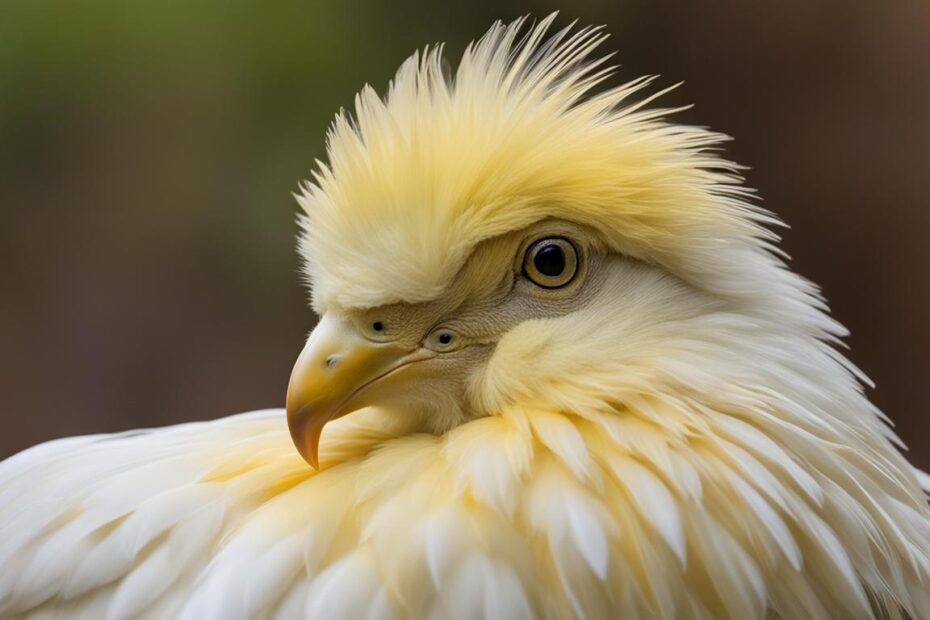Have you ever wondered what a fully feathered chick looks like? Understanding the appearance and development of chicks is essential for poultry enthusiasts and those who are curious about the various stages of chick plumage. From the initial pinfeathers to the mature contour feathers, each stage plays a crucial role in a chick’s growth and ability to thrive.
Key Takeaways:
- A fully feathered chick looks very different from the hatchling that emerged from its egg just a few weeks earlier.
- Chickens go through different stages of feathering, including pinfeathers, down feathers, and contour feathers.
- Pinfeathers are the first feathers that grow and are short, stiff, and sharp.
- Down feathers replace the pinfeathers and provide insulation and warmth.
- Contour feathers are the long, stiff feathers that cover the chick’s body and allow it to fly.
The Appearance of a Newly Hatched Chick
When a chick is newly hatched, it is a delicate creature covered in soft down feathers. These down feathers provide insulation and keep the chick warm during its early stages of life. The chick’s eyes are closed, and it relies on its instincts and the care of its parents for survival. At this stage, the chick is unable to walk or stand on its own, but it quickly develops strength and coordination as it grows.
The closed eyes of a newly hatched chick are due to the underdevelopment of its visual system. As the chick matures, its eyes will gradually open, revealing the world around it. This process can take a few days, and during this time, the chick relies on its other senses, such as hearing and touch, to navigate its environment.
Newly hatched chicks are vulnerable and require the care and protection of their parents or human caregivers. As they grow and develop, they will eventually become more independent, gaining the ability to walk, eat solid food, and explore their surroundings. This transformation from a helpless hatchling to a capable chick is a remarkable process to witness.
Chick Development in the First Few Weeks
During the first few weeks of a chick’s life, it undergoes rapid development both in terms of physical growth and feathering. This period is crucial for the chick’s overall development and sets the foundation for its future as a fully feathered chicken.
One of the key aspects of chick development during this time is its increasing water and food consumption. As the chick grows, its nutritional needs also increase, and it requires a steady supply of food and water to support its rapid growth. Adequate nutrition plays a vital role in promoting healthy feather growth and overall development.
Feather growth is another important milestone during the first few weeks of a chick’s life. Initially covered in down feathers, the chick gradually begins to develop larger and more mature feathers. These feathers not only provide insulation and help regulate the chick’s body temperature but also contribute to its ability to eventually fly and navigate its surroundings.
| Development Milestone | Description |
|---|---|
| Increased Water and Food Consumption | Chicks consume more water and food as they grow, supporting their rapid development. |
| Feather Growth | The chick develops larger and more mature feathers, contributing to insulation, temperature regulation, and eventual flight. |
“The first few weeks of a chick’s life are a critical period of growth and development. It is important to provide them with adequate nutrition and a comfortable environment to promote healthy feather growth and overall well-being.”
By around two weeks old, the chick should be able to walk and run on its own, showcasing its increasing strength and coordination. Feather growth continues throughout this period until the chick is fully feathered, which typically occurs around four weeks old. At this stage, the chick can be safely moved outside into a coop with other chickens, as it is better equipped to handle the natural elements and interactions with its flock mates.
Overall, the first few weeks of a chick’s life are a critical period of development that sets the stage for its future as a fully feathered chicken. Proper nutrition, adequate water supply, and healthy feather growth are key factors in ensuring the chick’s growth and well-being during this important time.

The Importance of Down Feathers
Down feathers play a crucial role in keeping baby chicks warm and comfortable. These soft and fluffy feathers provide insulation, helping the chicks regulate their body temperature effectively. Without down feathers, the chicks would be vulnerable to cold weather and temperature fluctuations, which could harm their health and development.
The fluffy appearance of down feathers is not just for aesthetics; it serves a practical purpose. The air trapped between the fluffy filaments creates a layer of insulation, keeping the chicks cozy and protected from the elements. This insulation is especially important during the early stages of a chick’s development when their ability to regulate body temperature is still developing.
Additionally, down feathers contribute to the overall growth and health of the chicks. As the feathers gradually replace the initial downy coat, they stimulate blood circulation and help the chicks develop stronger muscles. The growth of down feathers is an essential part of the chick’s journey towards becoming a fully feathered adult chicken.
| Benefits of Down Feathers in Baby Chicks |
|---|
| Provides insulation and warmth |
| Helps regulate body temperature |
| Stimulates blood circulation and muscle development |
| Contributes to overall growth and health |
“Down feathers are like nature’s cozy blanket for baby chicks, protecting them from the cold and ensuring their warmth and well-being during their early stages of life.” – Poultry Expert
As chicks grow older and progress through their feather stages, the down feathers will be replaced by more mature and functional feathers. These feathers, such as contour feathers, will provide greater protection and allow the chicks to fly once they reach adulthood. However, the importance of down feathers in the early stages of a chick’s life cannot be overstated. They serve as a vital source of warmth and comfort, ensuring the well-being and healthy development of these young and vulnerable creatures.
Feather Growth and Transition to Adult Feathers
Feather growth is an important process in the development of baby chicks as they transition into adult chickens. As the chicks grow older, they undergo molting, a natural shedding and replacement of feathers. This molting process allows for the growth of larger, stronger feathers that enable the chickens to fly and stay warm in cold weather.
The transition from down feathers to adult feathers typically occurs around two months of age. During this time, the down feathers gradually fall out, making way for the growth of adult feathers. The process can vary among breeds and individual chicks, but by three to four months old, the chicks should have developed their full complement of adult feathers.
Feather Growth: A Gradual Process
Feather growth in chicks is a gradual process that occurs over several weeks. Initially, the chicks have soft and fluffy down feathers, which provide warmth and insulation. As they continue to grow, these down feathers are gradually replaced by larger and more structured feathers. This transition is crucial for the chicks to adapt to their environment and become fully feathered adult chickens.
“Feather growth in chicks is a fascinating process to observe. It is incredible to see how their feathers develop and transform, ultimately enabling them to fly and thrive in their surroundings.” – Poultry Expert
During the feather growth process, it is important to provide the chicks with a balanced diet rich in proteins and essential nutrients. This will support healthy feather development and overall growth. Additionally, ensuring a clean and stress-free environment for the chicks will contribute to their well-being and promote optimal feather growth.
| Feather Growth Stages | Description |
|---|---|
| Down Feathers | Soft and fluffy feathers that provide warmth and insulation. |
| Covert Feathers | Intermediate feathers that offer some protection and flexibility. |
| Contour Feathers | The mature plumage of fully-grown chickens, providing insulation and the ability to fly. |
The successful growth and development of feathers in chicks are essential for their overall health and well-being. Feathered chickens are better equipped to regulate their body temperature, protect themselves from predators, and engage in natural behaviors such as flying and roosting. Understanding the process of feather growth and providing the necessary care and support will ensure that chicks develop into fully feathered adult chickens.

Factors to Consider When Moving Chicks to the Coop
Moving chicks from the brooder to the coop is an exciting milestone, but it requires careful consideration of various factors to ensure the chicks’ well-being and successful transition. Several key factors should be taken into account:
Chick Age
The age of the chicks plays a crucial role in determining if they are ready for the move. While chicks typically reach full feathering at around 6 weeks old, this can vary depending on the breed and individual development. It’s important to observe the chick’s feathering stage to assess their ability to regulate body temperature without supplemental heat.
Feathering
The feathering stage of the chicks is another important factor to consider. Fully feathered chicks are better equipped to handle temperature fluctuations and are more likely to thrive in the outdoor coop environment. Moving chicks that are still growing their feathers may leave them vulnerable to cold weather and potential health issues.
Temperatures
Temperature considerations are critical when moving chicks to the coop. Chicks require supplemental heat during their early weeks, especially in colder climates. Before making the move, ensure that the outside temperatures are suitable for the chicks to transition without the need for additional heating. Gradually acclimate the chicks to the cooler temperatures by reducing the brooder temperature over several days.
Coop Considerations
Preparing the coop for the arrival of the chicks is essential for their safety and well-being. Ensure the coop is predator-proof, with secure fencing and sturdy construction. Additionally, consider integrating the chicks with older flock members gradually to minimize stress and potential aggression. Provide adequate space, ventilation, and nesting areas in the coop to accommodate the growing chicks’ needs.
| Factors to Consider | Details |
|---|---|
| Chick Age | Observe the feathering stage and assess their ability to regulate body temperature without supplemental heat. |
| Feathering | Moving fully feathered chicks reduces vulnerability and ensures a smoother transition to the coop environment. |
| Temperatures | Ensure outside temperatures are suitable for the chicks without the need for additional heating. |
| Coop Considerations | Ensure the coop is predator-proof, integrate chicks gradually, and provide adequate space and resources. |
By considering these factors, you can successfully move your chicks to the coop and provide them with a safe and comfortable environment to continue their growth and development as fully feathered adult chickens.
Conclusion
Understanding the development stages and feather types of chicks is crucial to recognizing what a fully feathered chick looks like. From their initial down feathers to the mature contour feathers, each stage plays a vital role in their growth and well-being. Feather growth enables chicks to regulate their body temperature, protect themselves from predators, and communicate with other chickens.
By considering factors such as the age of the chicks, their feathering stage, and the environment they will be exposed to, they can be successfully transitioned to the coop as fully feathered adult chickens. It is important to note that the timing of full feathering may vary among breeds and individual chicks, so close observation and proper timing are necessary for a smooth transition.
As chicks progress through their feather stages, it is fascinating to witness their transformation from helpless hatchlings to independent and fully feathered chickens. The different types of feathers, such as filoplumes, down feathers, and contour feathers, all serve specific functions in a chicken’s life. Understanding these feather types is essential for keeping chickens healthy and comfortable.
Whether you are a seasoned chicken keeper or a first-time owner, knowing what a fully feathered chick looks like is an important aspect of understanding their development. By providing the necessary care and attention during the feathering process, you can ensure that your chicks grow into beautiful and thriving adult chickens.
FAQ
What does a fully feathered chick look like?
A fully feathered chick has long, stiff contour feathers that cover its body and give it its distinctive shape. It looks very different from the hatchling that emerged from its egg.
How does a newly hatched chick appear?
A newly hatched chick is covered in down feathers, has closed eyes, and is unable to walk or stand on its own.
What happens to a chick’s feathers in the first few weeks?
In the first few days after hatching, baby chicks consume a lot of water and food and grow their feathers. Feathers help regulate their body temperature and keep them warm.
Why are down feathers important for a baby chick?
Down feathers are soft and fluffy, providing insulation and warmth. They are crucial for keeping the chick warm and comfortable and allow the chick to regulate its body temperature effectively.
How do chicks transition to adult feathers?
Baby chicks will lose their down feathers and replace them with adult feathers. Feathers play a crucial role in a chicken’s ability to fly, stay warm, and communicate with other chickens.
What are the different types of chicken feathers?
Chickens have filoplumes, down feathers, and contour feathers. Filoplumes contribute to the development of other feathers and help with temperature regulation. Down feathers provide insulation and warmth, while contour feathers give chickens their shape and waterproof them in wet weather.
Are there chickens without feathers?
Yes, some breeds like the Silkie Chicken and Naked Neck Chicken are born without feathers. These chickens rely on their skin for protection and warmth.
What factors should be considered when moving chicks to the coop?
Factors to consider include the age and feathering stage of the chicks, temperature conditions, and coop considerations such as predator-proofing and integration with older flock members.
Why is understanding chick development important?
Understanding chick development and the stages of feather growth helps ensure the health and comfort of the chicks. Feathers play a vital role in a chicken’s ability to regulate body temperature, protect itself, and communicate with other chickens.


